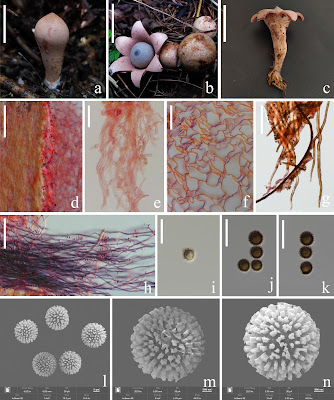Abstract
Background:
Geastrum is the largest genus of Geastraceae and is widely distributed all over the world. Four specimens which belong to Geastrum were collected during our scientific expedition to Cangshan Mountain, Yunnan, China. Based on morphological characteristics and phylogenetic analysis, a new species was introduced.
New information:
Geastrum suae is characterised by its large basidiomata (height 35–70 mm, diameter 18–37 mm) with long stipe (height 10–45 mm), smooth pink exoperidium and sessile globose endoperidial body. Phylogenetic analysis has been carried out, based on the internal transcribed spacer (ITS) and large subunit ribosomal ribonucleic acid (nrLSU) sequence data. The illustration and description for the new taxa are provided.
Keywords: Geastraceae, ITS, nrLSU, taxonomy, phylogeny
Geastrum suae Z.Q. Zhang C.H. Li & Z.L. Luo, sp. nov.
Diagnosis: Geastrum suae is characterised by long stipes and larger basidiomata; Pseudoparenchymatous layer is pink, smooth; globose endoperidial body, grey; the ends of eucapillitium hyphae taper and are bluntly rounded; and they live in groups.
Etymology: The species is named suae (Lat.), in memory of the Chinese mycologist Prof. Hong-Yan Su, who kindly helped the authors in many ways and sadly passed away on 3 May 2022 during the preparation of the current paper.
Habit: It grows in groups on the ground in mixed coniferous and broad-leaved forests where there are Alnus nepalensis and Pinus yunnanensis, with thick humus. Currently, it is known only from Cangshan Mountain.
Zheng-Quan Zhang, Chao-Hai Li, Lin Li, Hong-Wei Shen, Jun He, Xi-Jun Su and Zong-Long Luo. 2023. Geastrum suae sp. nov. (Geastraceae, Basidiomycota) A New Species from Yunnan Province, China. Biodiversity Data Journal. 11: e99027. DOI: 10.3897/BDJ.11.e99027

